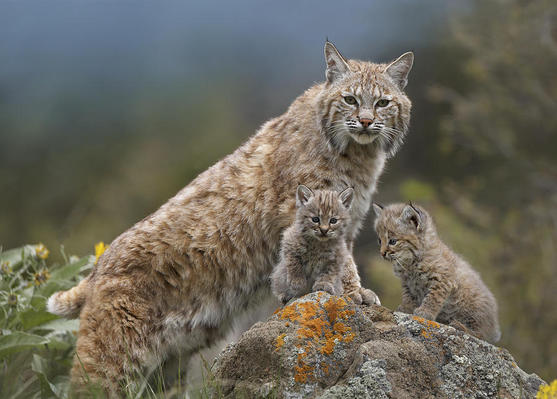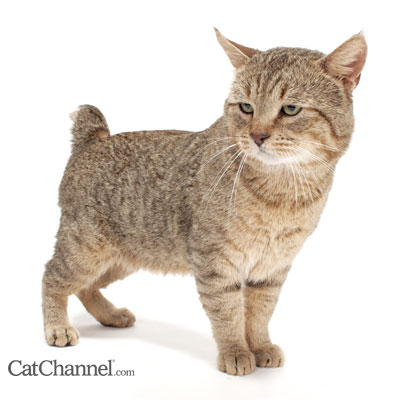
The Breed History
This breed was developed in America to be a bobcat look-alike. The
breed was developed from domestic cats. Though some report wild
Bobcat blood in the breed, DNA evidence does not support inclusion
of wildcat blood. In 1984 Pixie, a founding female was bred in
Washington State. Outcrossing to wild cats and pedigreed cats is
not allowed, though outcrossing to approved legend cats (native
brown tabby unregistered domestic cats with appropriate traits) is
allowed. TICA first accepted them as a provisional breed in 1994,
with full championship status in 1998.
Physical Characteristics
Weight: 10-18 lb (4.5-8 kg), some males larger.
Coat: The Pixie-Bob coat has extensive ticking and in the shorthair,
is quite short and dense. The coat is soft, and has elastic resilience.
There is a longhaired (actually a medium length coat) Pixie-Bob, and
the texture of that coat is soft and close lying. The longhair should
not have any ruff but mutton chops may be present. Random light
to medium brown tabby spotting is ideal; base color is mouse grey;
color may change quite a bit with the changing of the seasons.
Spots should be small, plus or minus a rosette. Classic and marble
tabbies also occur and are considered pet quality. Coat is water
resistant.
Eyes: A softly triangular shape, the eyes are deep-set with an
intense gaze, are medium sized, and hooded brows above are
prominent. A gold or brown eye is preferred though the green color
referred to as Gooseberry is accepted.
Points of Conformation: The large Pixie-Bob head is pear shaped,
with strong mascara markings and spectacles around the eyes. Chin
is white. Ears are set wide, with round tips; lynx tipping is preferred;
moderate in size. Nose is wide and slightly convex in profile, and
the muzzle is moderate in length; break is evident. Body is a heavy
build, prominent scapulae, flank is deep, chest is wide, and they are
large in overall size. Limbs are long and well boned and muscled.
Polydactyl cats are accepted (seven digit maximum). The tail is
usually about two inches long, but may extend to a maximum of
six inches; a kink or curl does not disqualify. When rear limbs are
extended, the tail should not reach past the tarsus. Paws are large,
round and compact. Pixie-bobs possess a typical rolling gait. A belly
pouch is evident.
Grooming: Low grooming needs for this breed, low tendency to mat.
Recognized Behavior Issues and Traits
Reported breed characteristics include: Affectionate, quiet, "one
man dog" cat, not particularly adaptable to changing homes; seem
to wag their short tail during play. They like to rule the home, so
sometimes best not to be with other pets. Curious, easily trained;
play fetch and leash walks. Good with children. Tend to make
chatter and chirp noises rather than typical cat meows. May be
somewhat cautious with strangers, and requires more attention
than some other breeds of cats.
Normal Breed Variations
None reported in the literature
Drug Sensitivities
None reported in the literature
Inherited Diseases
None reported in the literature
Disease Predispositions
Pancreatitis-anecdotal
Genetic Tests
None available commercially
Miscellaneous
- Breed name synonyms: Bobcat
- Registries: TICA (LH and SH separated), CCA
- Breed resources: The Official Pixie-Bob Site:
http://www.pixie-bob.org/
Photo Gallery of Breed - Pixiebob - Cat Breed








 Animalia Life
Animalia Life